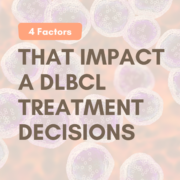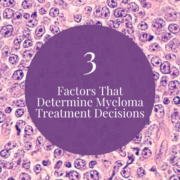Four Factors That Impact a DLBCL Treatment Decisions
Diffuse large B-cell lymphoma (DLBCL) treatment options may map differently depending on various patient factors. In the “Which Factors Impact DLBCL Treatment Decisions?” program, expert Dr. Justin Kline from University of Chicago Medicine explains key patient factors that effect DLBCL treatment decisions.
1. DLBCL Stage
The stage of diffuse large B-cell lymphoma (DLBCL) is a key factor in treatment decisions. Early stage DLBCL usually has more treatment options for patients. While later stage DLBCL – and other cancers – normally have fewer options since patients in later stages may have failed to show success with some previous treatments. Of course, other patient factors will impact the number of treatment options for each stage.
2. Patient Age
DLBCL specialists will take age into account in treatment options. However, a patient’s age does not necessarily rule out an aggressive treatment option. Full dose therapy may still be prescribed for elderly patients even in their 80s when curing DLBCL is the overriding goal of treatment.
3. Health Issues
DLBCL treatment options must also take into account other health issues of the patient. Considerations like heart health, kidney health, physical fitness, and medical problems like diabetes and high blood pressure must be considered. In addition, the patient’s DLBCL symptoms must be weighed in the analysis for treatment decisions.
4. Quality of Life
The quality of life of a specific DLBCL patient must also be evaluated in treatment decisions. Quality of life is examined in two different situations. One situation involves treatment side effects. Treatment side effects can vary by treatment and commonly include issues like fatigue, nausea, vomiting, constipation, hair loss, mouth sores, and immune suppression among others. The second way that quality of life can come into play is for elderly patients or those who have many health issues. In these cases, a more gentle, palliative approach may be taken to maintain a better quality of life rather than a very aggressive approach that would be very difficult on the patient.
DLBCL treatment decisions take several factors under consideration for optimal patient care. If you’d like to learn more about DLBCL care and treatment, check out our DLBCL information.










